Ursule Babey 2019
Archaeological research
Up to the beginning of the 3rd millennium, all that was known about the Cornol faience manufactory came from a publication about the Jura region by art historian Gustave Amweg (Amweg 1941). A landslide that occurred in 2003 on the edge of the former factory (now a restaurant) provided an opportunity for us to examine the contents of the levelled layers of soil between the building and the stream in front of it. The levels were full of all kinds of ceramic fragments. The archaeological excavations carried out in three stages (in 2003, 2004 and 2007) yielded an assemblage of some 100,000 fragments from the workshop’s waste dump. This formed the basis for a study that revealed new insight into the production of the Cornol-Lion d’Or faience factory. Besides kiln equipment (kiln furniture, saggars etc.), the dump also yielded a significant number of biscuit-fired pieces, which allowed us to identify specific shapes and decorations, as well as fragments of white faience, both painted and unpainted, and tableware with manganese black glazed reverse sides (“à cul noir”) or with manganese purple speckled decoration (“moucheté”). There were also fragments of refined white earthenware and stove tiles.
The excavations did not, however, uncover any features associated with the factory operation itself.
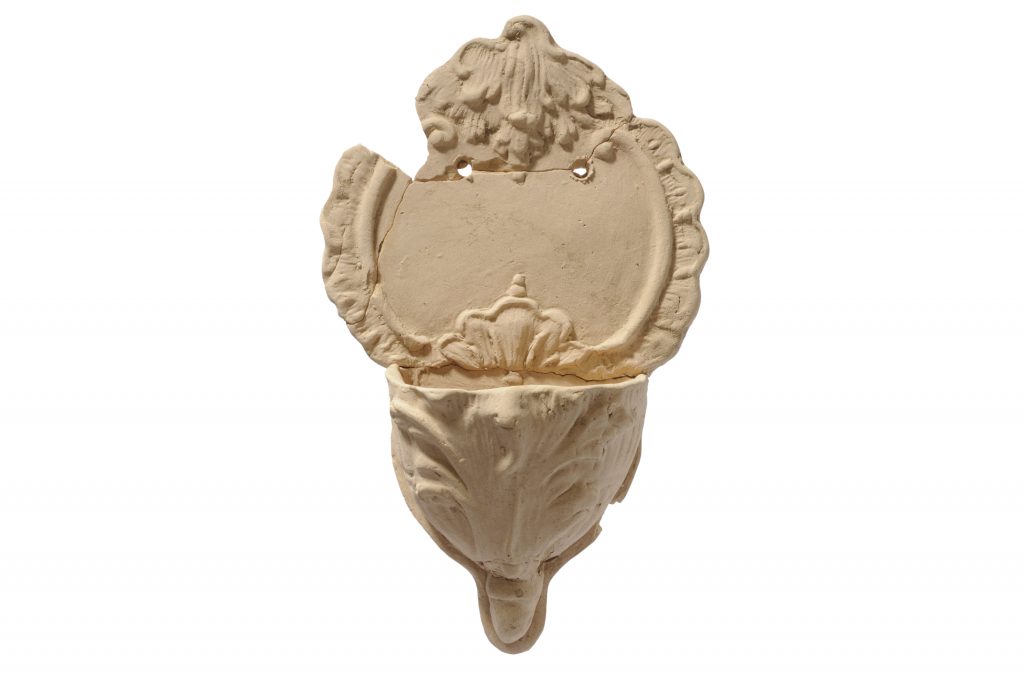
Small domestic stoup with rocailleries and sunburst motifs. Moulded and biscuit fired. Height: 16.3 cm, c. 1760-1770. Cornol-Lion d’Or excavations (photo: OCC-SAP, B. Migy). Ref. CAJ 37, Pl.40.389.

Fragment of a plate with indented rim, moulded and biscuit fired. Garland of flowers in relief. Diameter: c. 32 cm, late 18th or early 19th century. Cornol-Lion d’Or excavations (photo: OCC-SAP, B. Migy). Ref. CAJ 37, Pl. 39.375.
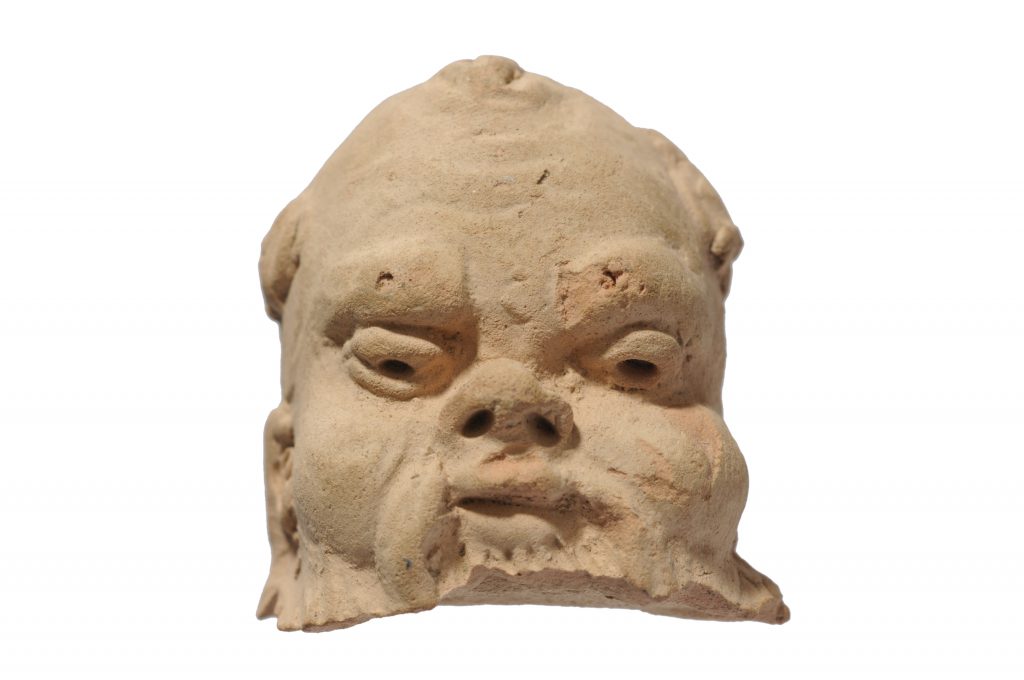
Handle or knob (?) in the shape of a satyr, moulded and biscuit fired. Height: 3 cm, late 18th century. Cornol-Lion d’Or excavations (photo: OCC-SAP, B. Migy). Ref. CAJ 37, Pl.26.225.
Besides excavating the waste dump, the archives of several public collections were also searched for relevant information. The historical sources allowed us to identify various actors associated with the faience manufactory (founders, owners, production managers, potters, painters, workers, merchants) and describe their economic strategies, their social environment, their business activities and their company handovers. Based on a detailed description of the tools and equipment along with mentions of certain technical and commercial aspects, we were able to ascertain how the production itself was organised. However, no written documents from the manufactory or company archives were found.
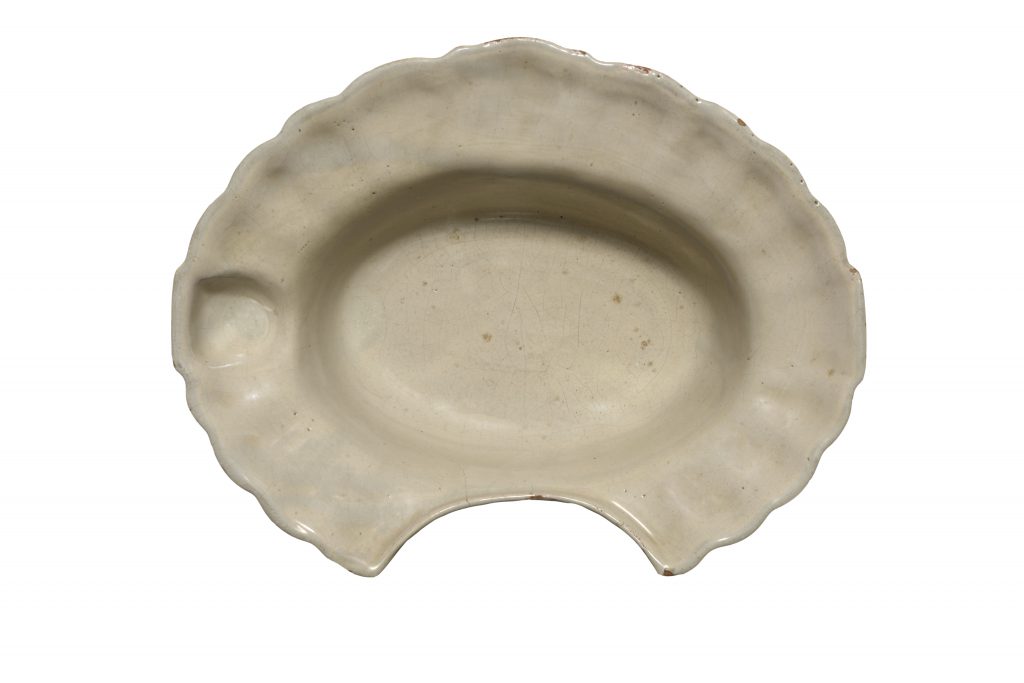

Shaving basin with white faience glaze, attributed to Cornol thanks to the comparison with a biscuit-fired equivalent. The latter has the same features: the shape of the rim, the position of the well for the thumb and the shape of the semicircular indentation for the neck. Museum der Kulturen (Museum of Cultures) Basel, inv. VI.4411. (photo: OCC-SAP, B. Migy). Ref. CAJ 37, S. 182, Fig. 128.
Overall context
The history of Cornol pottery goes back to the end of the 17th century. At that time, its potters probably made tableware using local raw materials such as the blue Oxfordian marls which had formed approximately 160 million years ago at the bottom of a shallow sea and which contained large, extremely dense deposits consisting of an homogenous, very fine-grained and compact clay. They commonly occur throughout the Ajoie region and were easily accessible in the last Jurassic fold in and around Cornol. The fact that there was already a pottery-making tradition in the locality must have played an important role when it came to choosing Cornol as the site for the only faience manufactory in the Prince-Bishopric of Basel.
When the manufactory was established in 1760, the local economy was dominated by the steel industry. Although steel production required huge amounts of charcoal, it was nevertheless crucial for the financial balance of the state, which controlled the entire chain of operation and distribution. It was originally promoted by Prince-Bishop Jakob Christoph Blarer von Wartensee who recognised all the industry’s advantages and made use of them from as early as 1575, to reinvigorate the ailing economy of the Prince-Bishopric of Basel. Other wood-burning industries, such as the pottery industry, were thus overshadowed.
History of the faience manufactory
Georges Humbert Triponez (1727-1767), a lawyer at the court of the prince-bishop, was only 33 and had no professional background whatsoever in pottery production, when he applied for permission to establish a faience manufactory in Cornol on 25th June 1760. His motivation still remains a mystery, as neither his origins nor his legal education, nor his family background would have inclined him towards such an entrepreneurial adventure which, given the economic circumstances that existed during the ancien regime, was a rather radical decision to make. In fact, in the region at the time there were very few entrepreneurs in the modern sense of the word.
The only plausible explanation is that the whole of mid-18th century eastern France was caught up in a tidal wave of enthusiasm for faience, and this was particularly true of the Franche-Comté region; also, Triponez had studied jurisprudence at Besançon. By chance, he met two faience makers in the town of Porrentruy who were looking for a site to set up a workshop. He decided, not only to help them find a suitable location, but to lend a hand in building up the business from scratch. He had no difficulty in obtaining a permit and was also granted a monopoly on producing faience, the right to exploit raw materials, to purchase wood and to hire specialists from abroad, who were even exempt from paying the departure tax. Triponez made a good start in the pottery business, as his faience manufactory was located in the Ajoie, far from the steelworks, which had a monopoly and were the main source of revenue for the state coffers. However, these promising beginnings were short-lived. In truth, he was viewed as an outsider by the people of Cornol, who was also bringing foreign workers into the village. On top of his endless financial problems, he also had to contend with constant aggression and even with physical violence. In 1766 he forged an alliance with Charles Exchaquet from Court, who was planning to open his own faience factory there. The collaborative endeavour came to an abrupt end when Triponez died suddenly at the age of 40. Encumbered with debt, the enterprise was gradually taken over by various creditors, either on their own or as part of consortia. Up to the end of the ancien régime, the company never achieved profitability, and apart from the initial support from the prince-bishop, the faience manufactory never received any other help, be it from the corporation or from local people, who were even openly hostile towards it.
The French Revolution and the incorporation of the region into France was a difficult period for the small enterprise. It eventually diversified into producing roof tiles, which at the beginning of the 19th century had not yet become widespread in the area. Faience production completely ceased in the first quarter of the century, while roof tiles continued to be made until 1861, when the premises were taken over by an innkeeper, who installed a pottery workshop with two kilns. The workshop remained in operation for approximately ten years.
The range of products
Tableware, serving dishes, objects for personal hygiene and stove tiles – the products from Cornol served the same functions as those from any other faience manufactory at the time. As far as its resources and technical abilities allowed, the company moved to fill any gaps in the market and to create the niche products that were fashionable at the time.
In terms of the shapes and decorations, many different styles were intermixed, which reflects the historical changes and existential difficulties the manufactory had to contend with. Accordingly, there was not one specific “Cornol” style, but several.

Small faience plate with a flat, straight rim and in-glaze painted decoration in blue without black outlines (“qualité non contournée”). Diameter: 19.6 cm, early 19th century. Cornol-Lion d’Or excavations (photo: OCC-SAP, B. Migy). Ref. CAJ 37, Pl. 57.484.
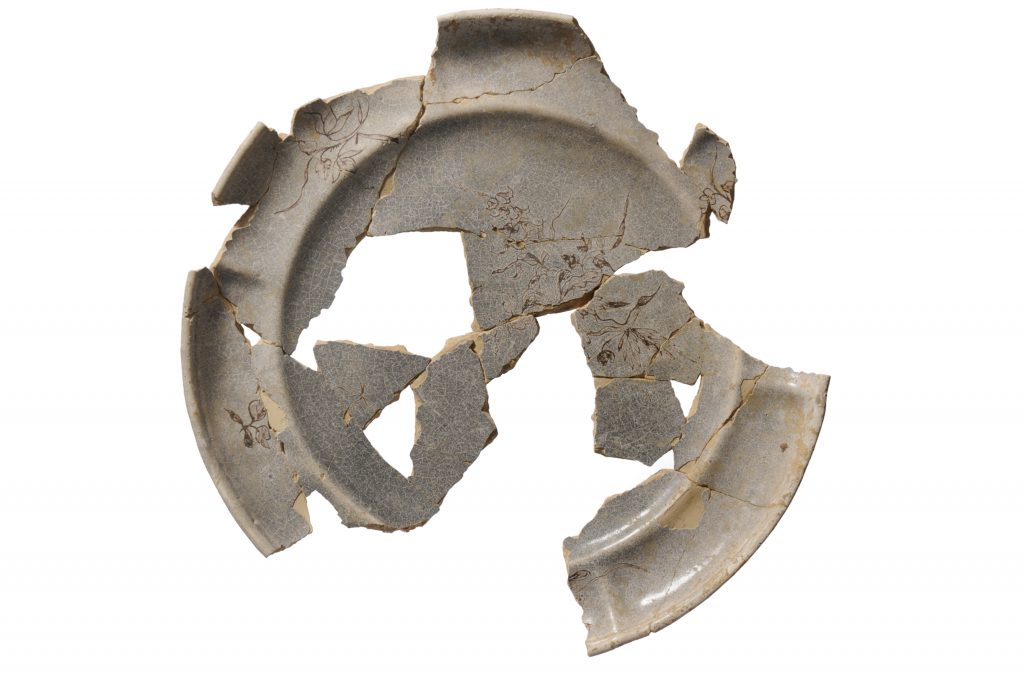
Flat faience plate with indented, concave rim and in-glaze painted decoration with outlines (“en qualité contournée”). The well is decorated with a bunch of carnations and bellflowers in manganese purple while the lip is painted with four different flower stems. Waster, overfired in reducing atmosphere. Diameter: 26 cm, c. 1760-1770. Cornol-Lion d’Or excavations (photo: OCC-SAP, B. Migy). Ref. CAJ 37.
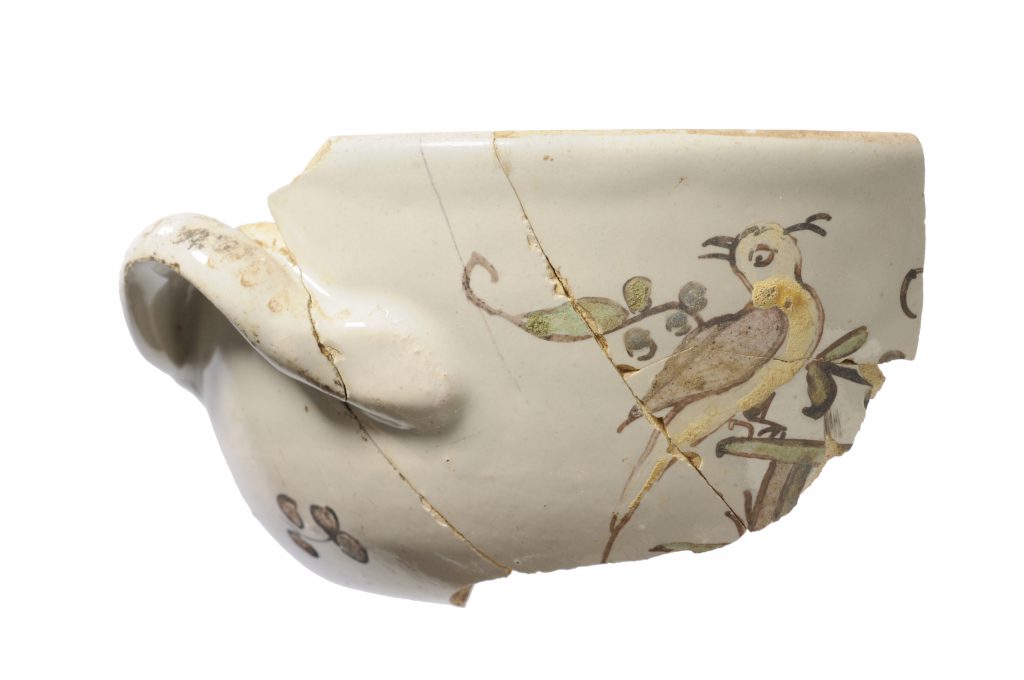
Some intact examples from Swiss museum collections can be linked to the wasters found during the excavations, including a soup bowl, which was previously believed to have come from Lenzburg, and a series of flat plates with lobed rims marked on the back with a “C”.
Because none of the objects were signed, it was not possible to link any of the finds recovered during the excavations with any of the craftsmen mentioned in the archive. However, the passport of a faience salesman which bore the seal of the manufactory from 1770, allowed us to link the pieces marked with a “C” to Jean-Baptiste Snamenatzky, faience maker and at the time director and leaseholder of the manufactory. Snamenatzky is highly likely to have come from somewhere in eastern Europe. His presence in Cornol can be confirmed for the period between April 1769 until his death in 1795. He was married to a woman from Bassecourt and the couple had seven children; all three of their sons also became involved in faience production.
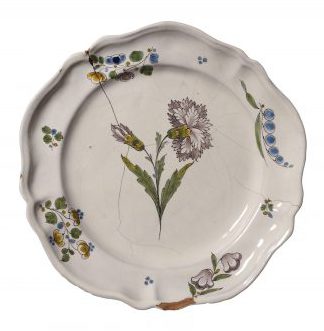
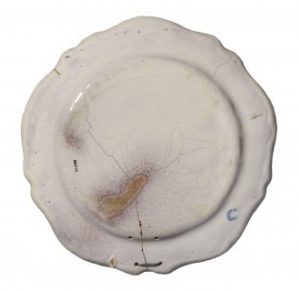
Faience plate decorated with carnations and bearing a painted mark “C” on the back; in-glaze painting. The letter “C” for Cornol was the main element of the company seal. The carnation and bellflower motifs are similar to those found on some of the fragments from the Lion d’or excavations. C. 1770. Museum of Cultures, Basel, inv. VI.3385. (Photo : OCC-SAP, B. Migy). Ref. CAJ 37, p. 194, Fig. 144.
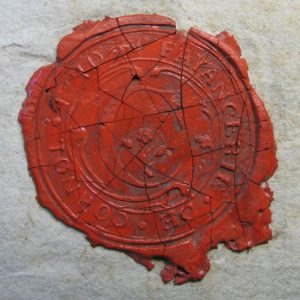
Seal in red wax bearing the coat of arms of the Cornol faience manufactory. The centre is dominated by a floral letter “C” surrounded by stylised branches and the inscription: “FAYANCERIE DE CORNOL 1770”. Diameter: 2.8 cm. Archive of the former Diocese of Basel, Porrentruy, GHFAM 4, passport dated 7th April 1770. Ref. CAJ 37, S. 134, Figures 63 and 64.
Translation Sandy Haemmerle
References:
Amweg Gustave, Les arts dans le Jura bernois et à Bienne. II. Arts appliqués. Chez l’auteur, Porrentruy 1941.
Babey Ursule, Johann Jacob Frey. Le faïencier qui aimait trop la porcelaine – deux essais d’implantation dans le Jura méridional. Revue des Amis suisses de la céramique 123, 2010, 29-49.
Babey Ursule, Archéologie et histoire de la terre cuite en Ajoie, Jura, Suisse (1750-1900). Les exemples de la manufacture de faïence de Cornol et du centre potier de Bonfol. Office de la culture et Société jurassienne d’Emulation. Cahier d’archéologie jurassienne CAJ 37. Porrentruy 2016. Pour se procurer un exemplaire : https://www.jura.ch/fr/Autorites/Archeologie-2017/Publications/Les-cahiers-d-archeologie-jurassienne-CAJ.html

